Incredible Porcelain Clocks In And From Meissen, Germany
How much of the following describes you? I am fond of ostentation, splendor, decadence, collecting, kitsch, fine arts, opulence, beauty, decorative items, and/or craftsmanship.
Have you ever thought about a classic mechanical clock or porcelain “made in Germany” or “ made in Meissen?”
According to historians, most of these characteristics would probably have applied to Augustus II the Strong (1670–1733), elector of Saxony and later king of Poland. Augustus – a real super collector in the truest sense of the word – had amassed so many objects to feed his passion that today several museums are necessary to show all of them.
Among his collections are many pieces of art, astronomic tools, scientific measuring instruments, clocks, and precious stones. Elector August was also significantly involved in the collection and even production of porcelain.
Art-interested visitors to Dresden are well-advised to visit August the Strong’s porcelain collection, which is part of the Saxon State Art Collections in Dresden. And anyone who has enjoyed that might also visit the famed porcelain collection in the city of Meissen, which is only 30 kilometers northwest of Dresden.
Here, passion for mechanical timepieces collides with passion for porcelain. Among the more than 2,000 pieces on show in the Meissen porcelain collection, there are permanently about 100 clocks in porcelain cases. One of the biggest is the “Angels and Arts” table clock, whose movement and dial are signed by Ernst Pfannschmidt.
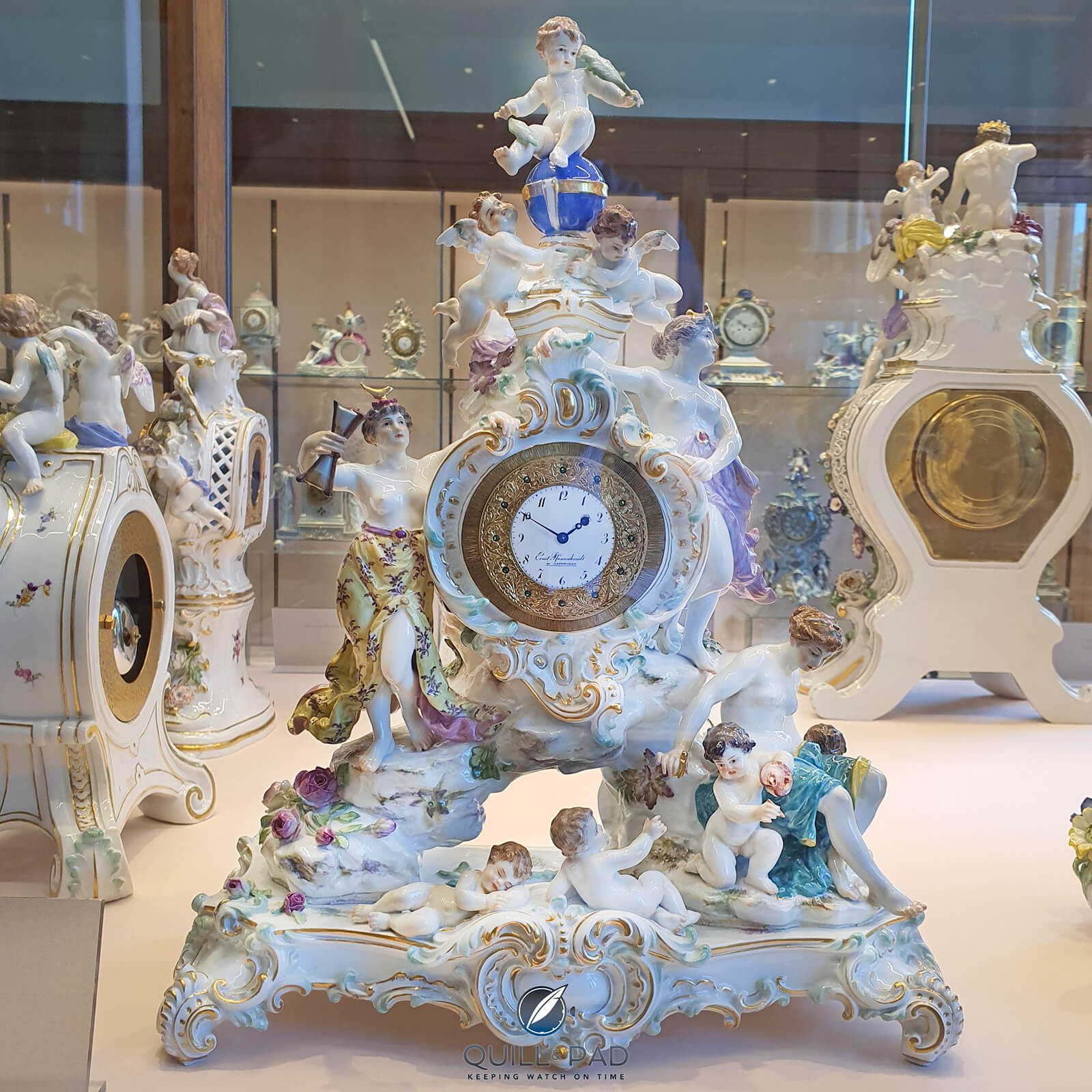
A time-only large table clock called ‘Angels and Arts’ from about 1880 in Meissen’s porcelain museum (photo courtesy Thomas Brechtel)
Meissen porcelain: material and manufacture
Meissen porcelain has existed since about 1708 and consists of a mixture of kaolinite (porcelain clay found near Meissen), feldspar, and quartz. During the manufacturing process it is fired twice: first at 900–1,000 degrees Celsius and then again at 1,100–1,500 degrees Celsius. This process is responsible for the porcelain’s characteristic shiny white and hard, but also fragile character. Typical for the manufacturing process is the shrinkage that results from the firing process, which causes the porcelain to shrink by about 16 percent.
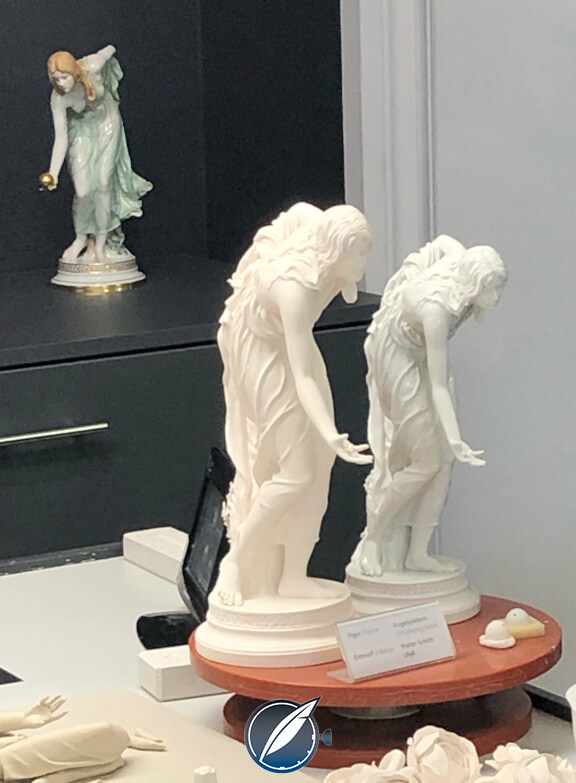
Meissen porcelain shrinkage (photo courtesy Thomas Brechtel)
Double firing means that the porcelain piece can be made pure white or decorated in many colors, which can be either under or over the glaze. Decoration in Meissen is done using more than 600 special colors as well as precious metals and it is executed by trained porcelain painters. Porcelain is highly fragile and very expensive, but it is a craft par excellence.
As a child I did not always know that as the many broken items my parents had to pay for unfortunately testify. Small mechanical porcelain table clocks typically resided in most living rooms of middle-class European households as recently as last century.
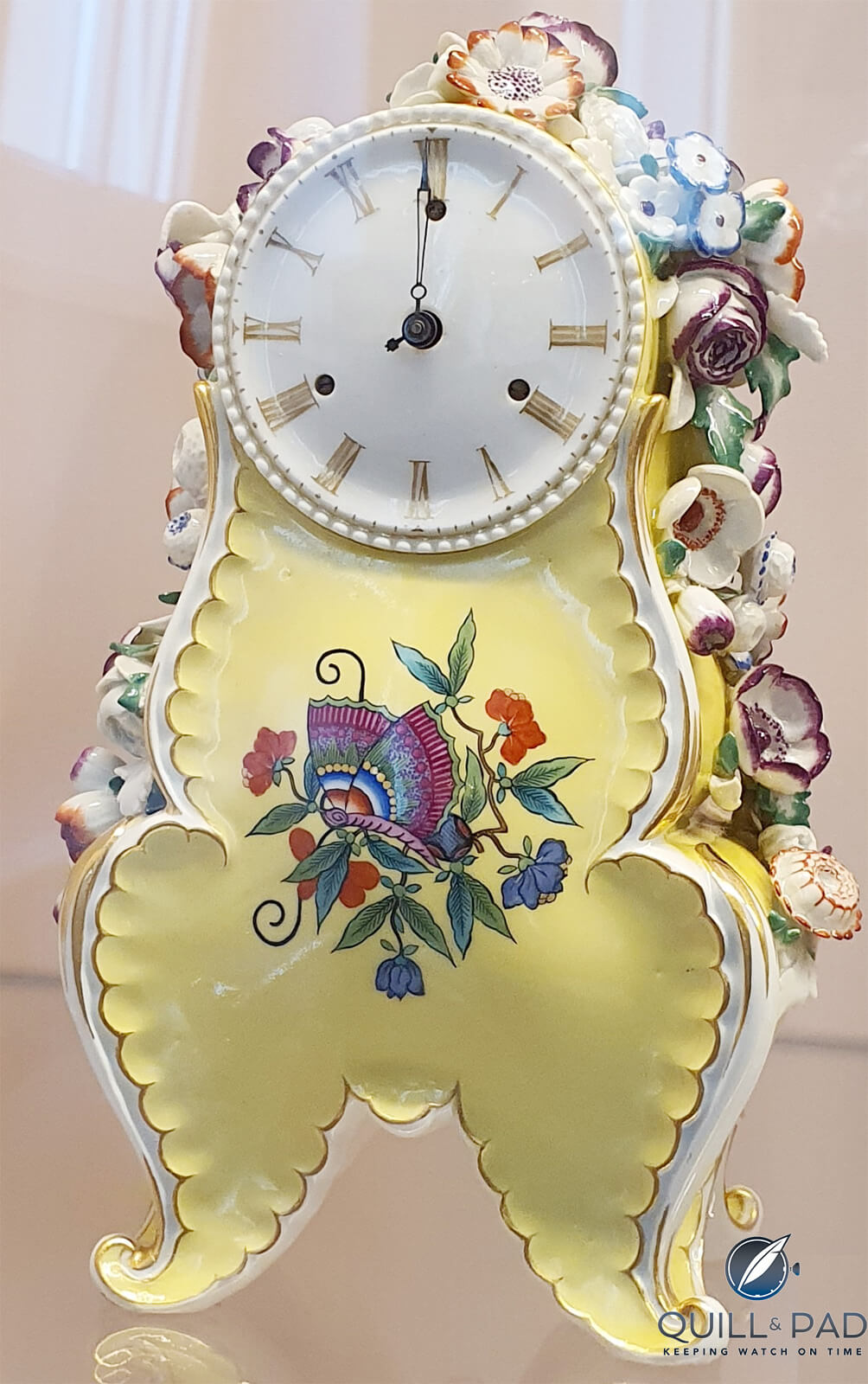
A small Meissen clock decorated with flowers by Emil Paul Börner from 1916 (photo courtesy Thomas Brechtel)
Making porcelain in Meissen: the crossed sword logo
Porcelain from the Saxon city Meissen belongs to the great artistic traditions of European decorative arts. In 1708 Johann Friedrich Böttger along with Ehrenfried Walter von Tschirnhaus and Gottfried Pabst von Ohain succeeded in inventing fine European porcelain.
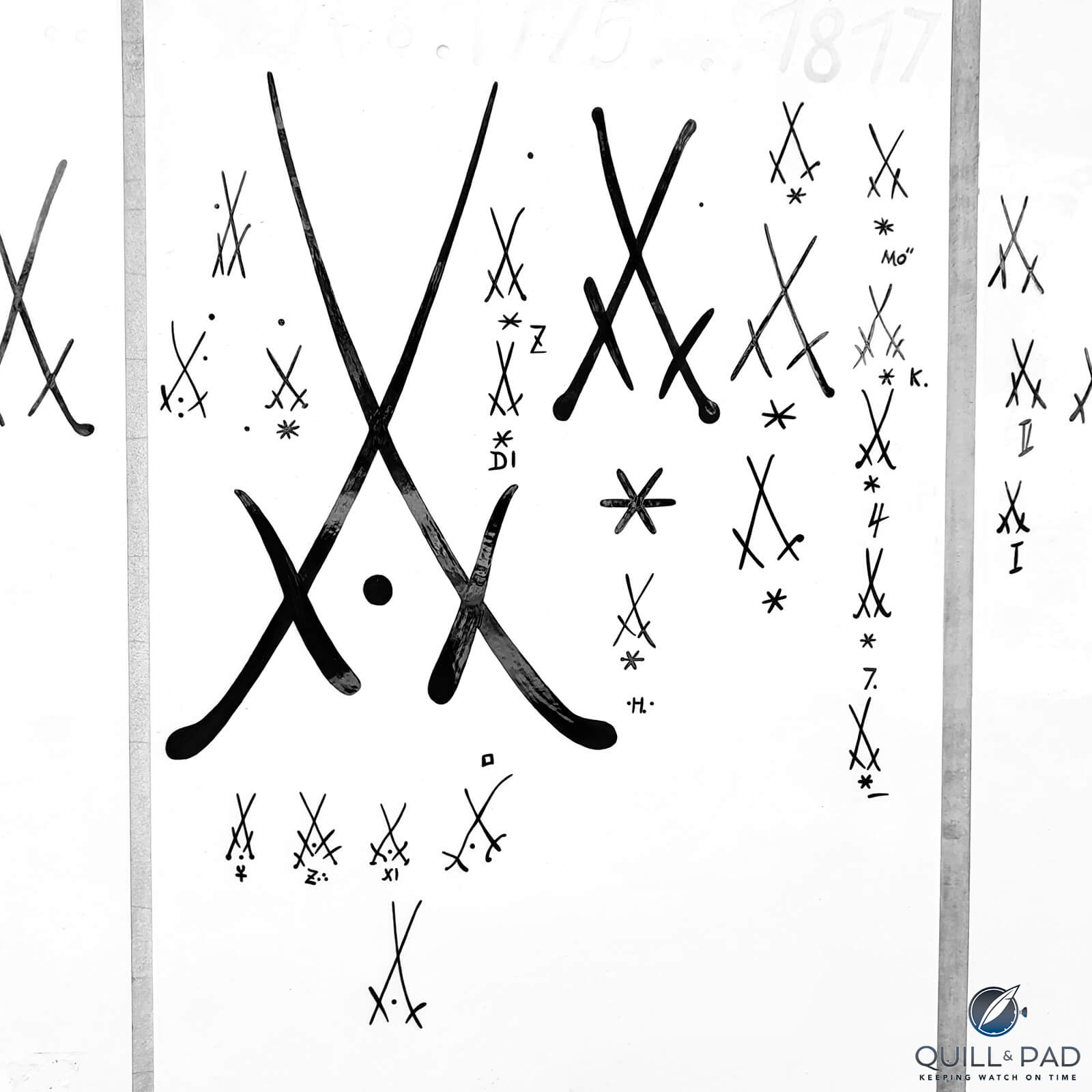
Famed crossed swords of Meissen, hallmark of the Meissen brand as seen on a tile outside the Meissen factory (photo courtesy Thomas Brechtel)
To this day, the Meissen manufactory continues to produces a variety of porcelain products. Since the beginning, numerous famous porcelain embossers, sculptors, artists, and painters have left their marks on this brand – such as Johann Gottlieb Kirchner (sculptor) and Johann Gregorius Höroldt (porcelain painter).
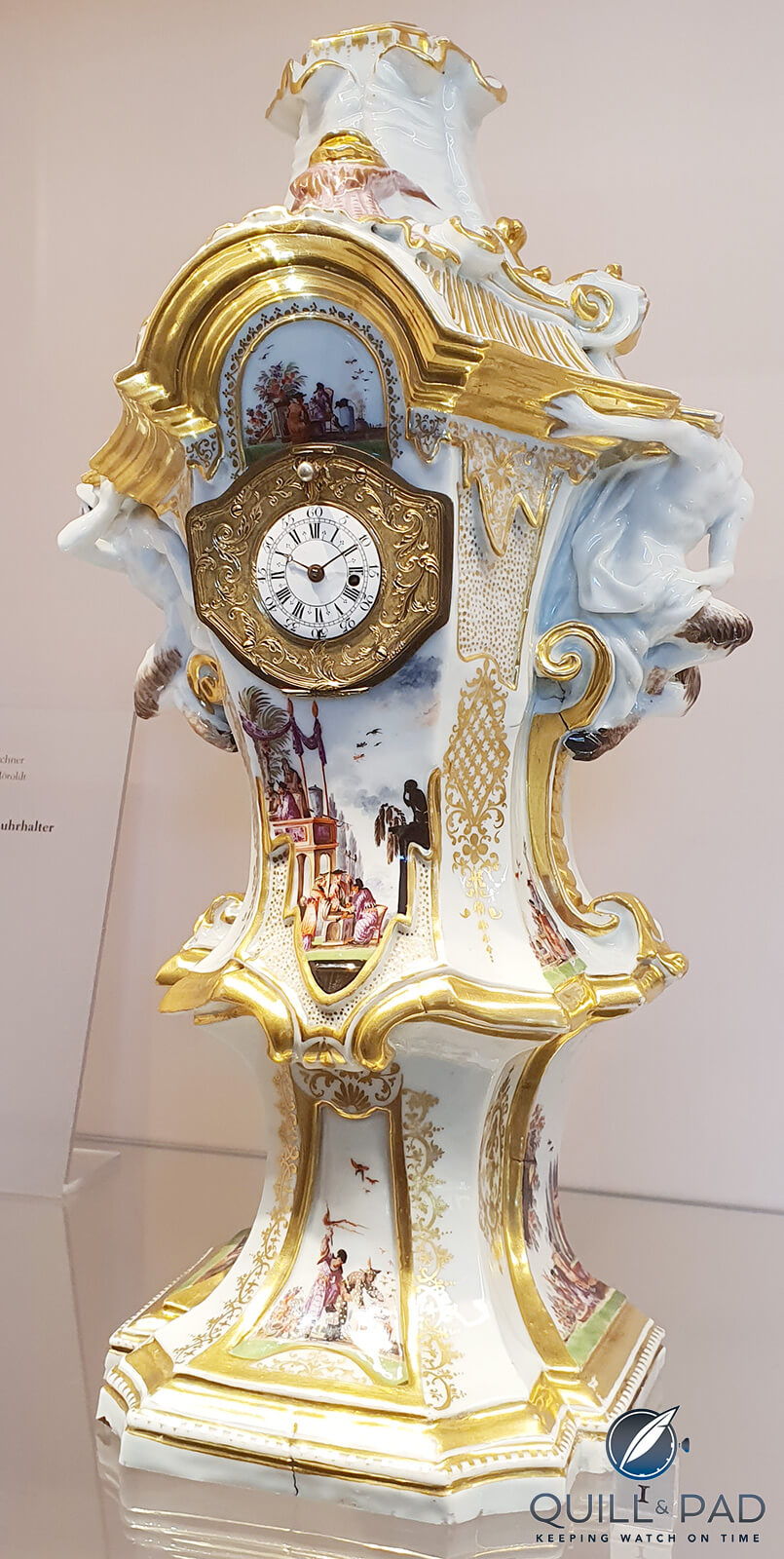
Meissen clock decorated with fauns by Johann Gottlieb Kirchner and Johann Gregorius Höroldt, about 1728 (photo courtesy Thomas Brechtel)
Watches and porcelain
All this talk about porcelain brings to mind wristwatches featuring fine porcelain dials. A Rolex Daytona Chronograph Reference 16520 with a white porcelain dial and Zenith movement from the late 1980s exists, for example, as does a classic Patek Philippe Calatrava Reference 3919 with white porcelain dial from the 1990s.
A bit rarer and less well known are the various wristwatches by Glashütte Original with Meissen dials marked with the legendary blue crossed swords of the famous Meissen brand. These include Reference 100-10-05-04-04 and the even rarer Glashütte Original 1845 Reference 49-08-97-97-06 with a porcelain dial and beautiful golden scenery. And in 2009, Glashütte Original introduced the Senator Meissen Tourbillon Reference 94-11-01-01-04 in a 40 mm pink gold case framing a wafer-thin, white Meissen porcelain dial proudly emblazoned with the blue crossed swords of the porcelain manufactory.
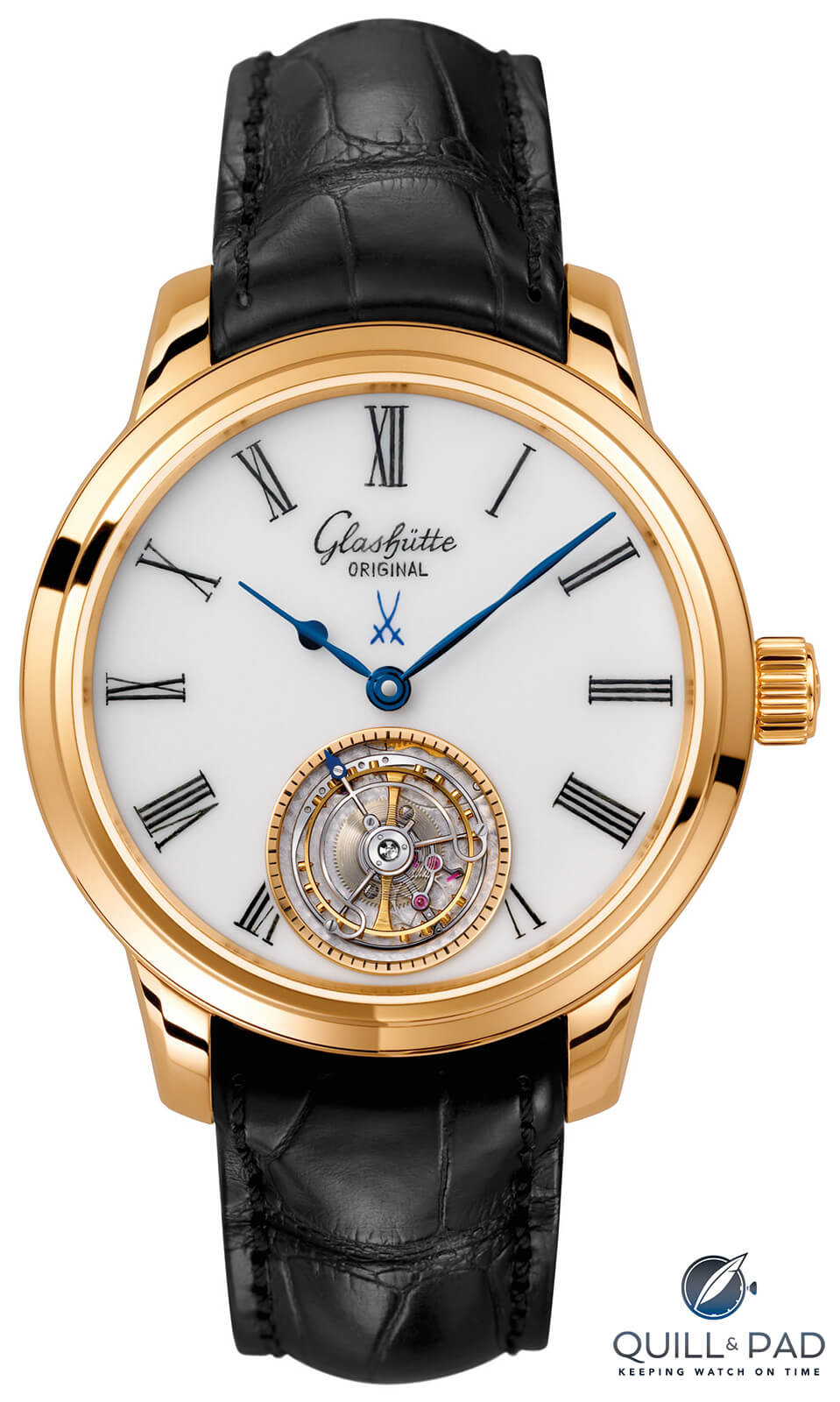
Glashütte Original Meissen Tourbillon Reference 94-11-01-01-04 from 2009
And who could forget 2015’s beautiful Slim d’Hermès Koma Kurabe with an authentic Japanese porcelain enamel dial?

Slim d’Hermes Koma Kurabe “La femme aux semelles de vent” (photo courtesy Claude Joray)
The Meissen porcelain clock collection: movements and makers
Some very famous artists and craftspeople worked for Meissen in the service of porcelain clock cases, among them artist and sculptor Emil Paul Börner and medalist Johann Joachim Kaendler. The collection, which exhibits more than 200 years of artistic craft, also contains pieces by Johann Daniel Schöne, Christian Gottfried Jüchtzer, and Peter Reinicke.
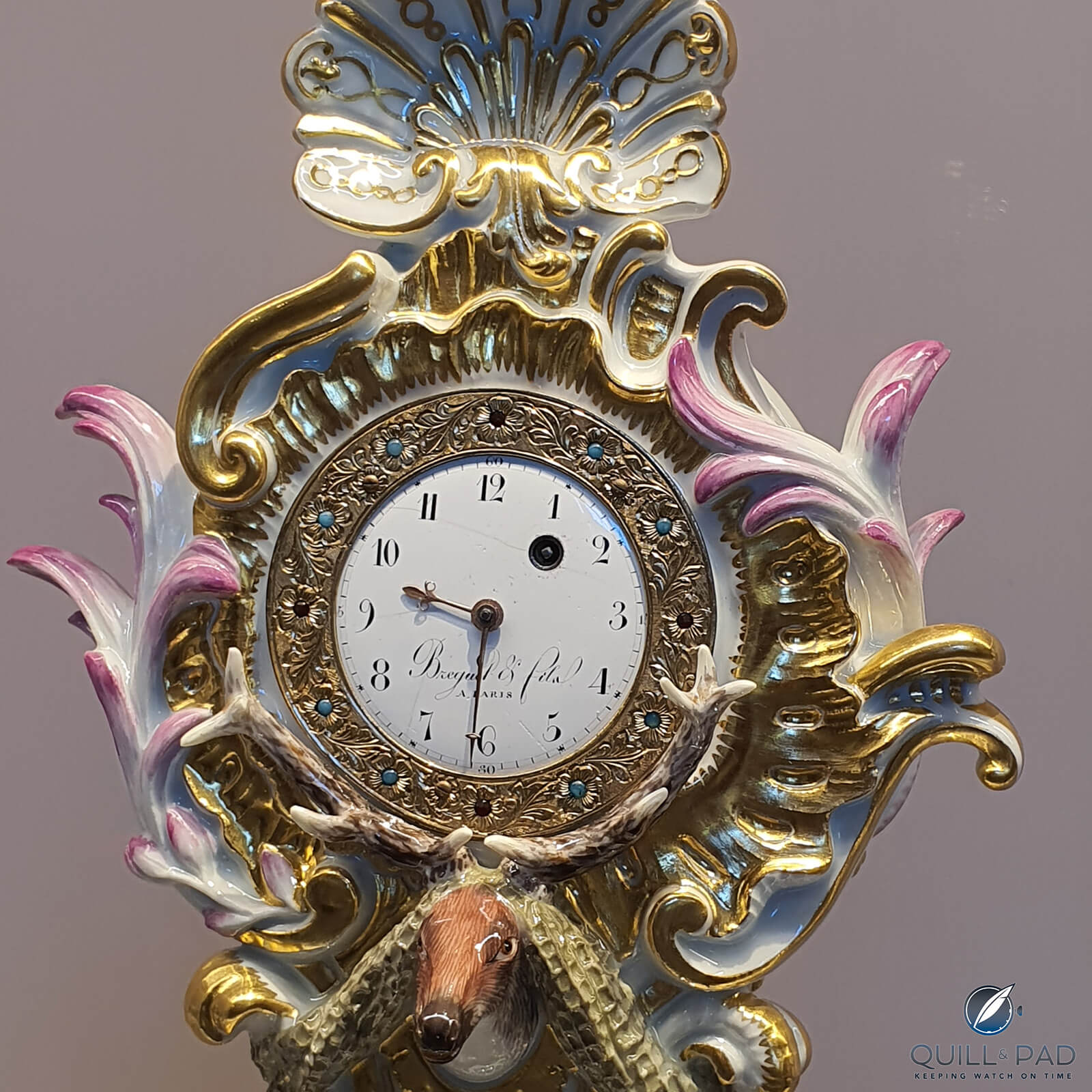
Movement and dial signed Breguet et Fils à Paris: clock with deer head by Johann Joachim Kändler from about 1750 (recast of the original from 1914) (photo courtesy Thomas Brechtel)
For those with the wish to see famous names and prominent masters on the dials of antique clocks or watches, such masters can also be found in the collection of porcelain clocks of the Meissen manufactory. There are, for example, several beautiful clocks with dials signed by Breguet, Paris in porcelain cases with animal motifs by Johann Joachim Kändler, or in much more classical-looking cases by Michel Victor Acier.

Classic ‘vase clock,’ Michel Victor Acier, about 1772, recast of the original model made about 1840, Breguet et Fils, Paris (photo courtesy Thomas Brechtel)
The beautiful clock with vase and pedestal made by Ludwig Eduard Martin shown below has an antique design that is characteristic of the late eighteenth century, which has a less playful, less ornate, and very classic style. The case is made of porcelain, the blue and gold decoration is over-glaze painting. Additionally, the case is decorated with gold leaf. The white dial has Roman numerals, a railway minute track, and Breguet-style hands.
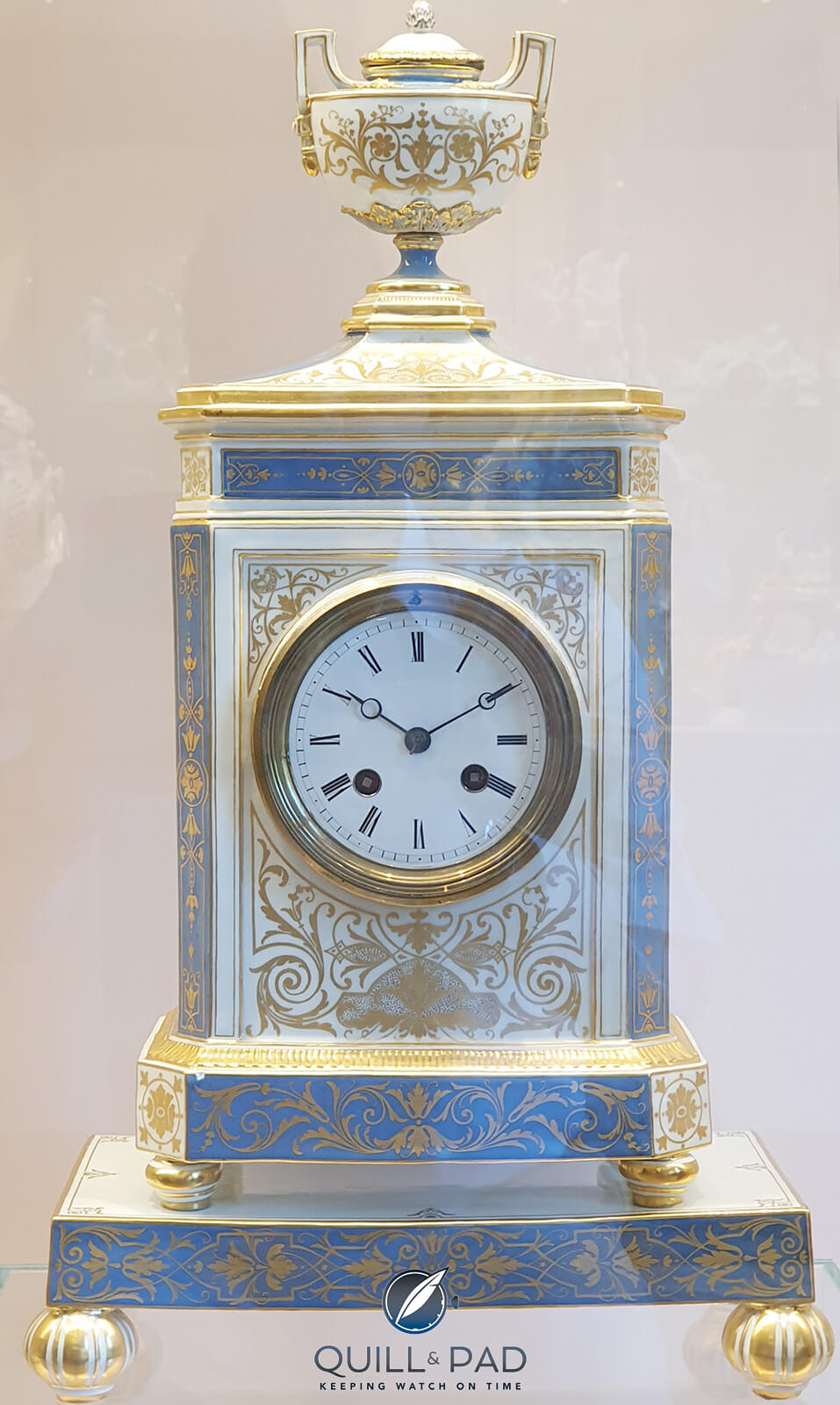
Meissen clock comprising vase and pedestal in blue and gold by Ludwig Eduard Martin, 1875 (photo courtesy Thomas Brechtel)
Very early, around 1720, the first artists were engaged in the design and manufacture of clock cases made of Meissen porcelain, like Johann Gottlieb Kirchner. Some of the clocks exhibited in the Meissen museum have cases that are very clean and undecorated, while other models are rather ornate with figures, scenery, and jewels so that the mechanical clock with its dial and movement and perhaps complication plays a more subordinate role.
Up to the twentieth century, the decoration of the clocks and their cases were completely in the foreground. Large clocks with porcelain cases fell into the collecting sphere and artistic taste of enthusiasts at royal courts and in aristocratic circles. Often they were given as valuable gifts.
The clock shown below by Johann Daniel Schöne and Christian Gottfried Jüchtzer is decorated with figures of the Greek muses Melpomene and her sister Thalia (tragedy and comedy) holding smiling and crying masks, the age-old symbol of theater. These two characters belong to the group of inspiring muses of art and science.
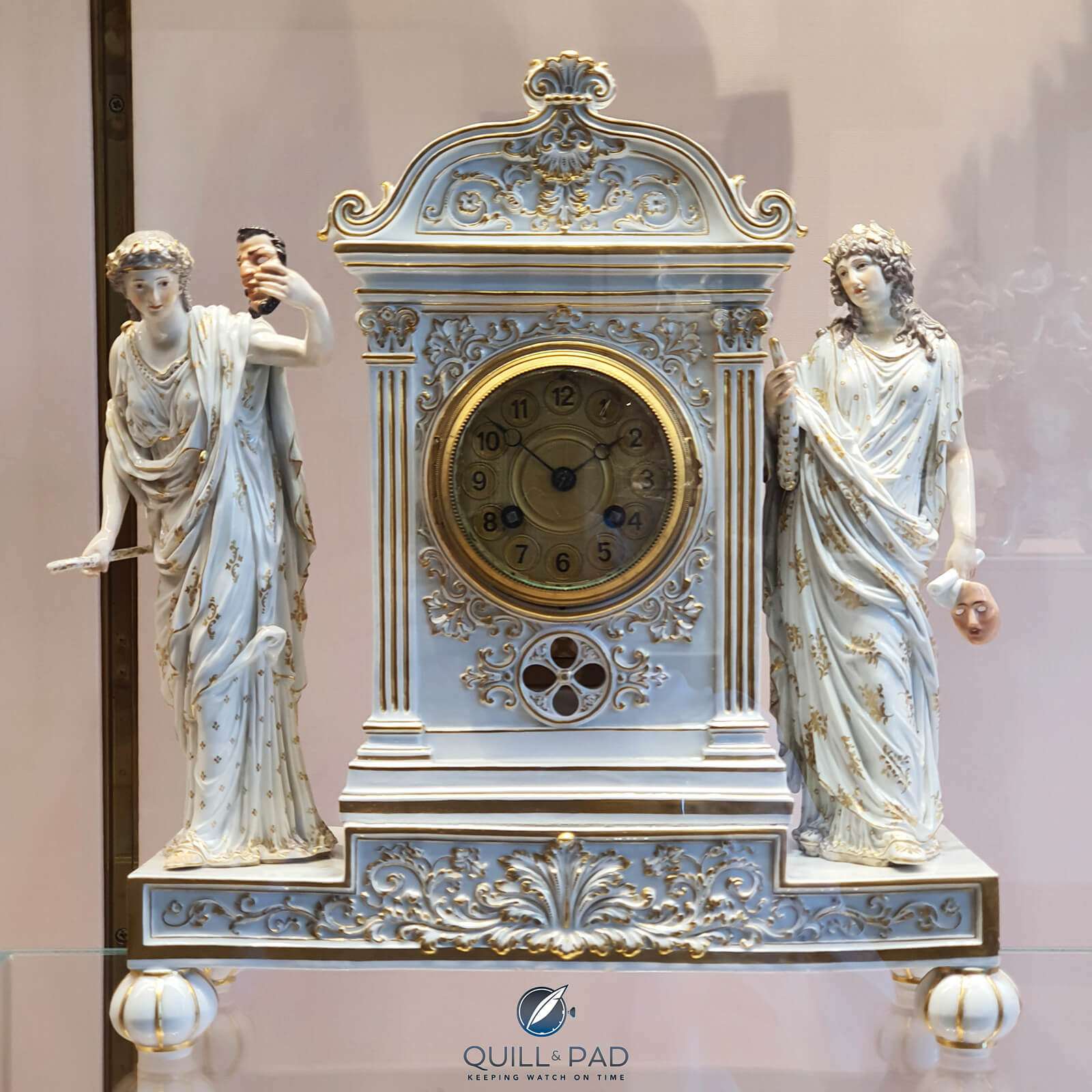
Meissen clock decorated with figures of Greek muses Melpomene and Thalia by Johann Daniel Schöne and Christian Gottfried Jüchtzer, 1870-1890 (photo courtesy Thomas Brechtel)
The museum’s collection both includes table clocks with built-in movements and decorative objects such as the small stand below made to hold an antique pocket watch. Made by Peter Reinicke in about 1747, could it be depicting “Father Time?”
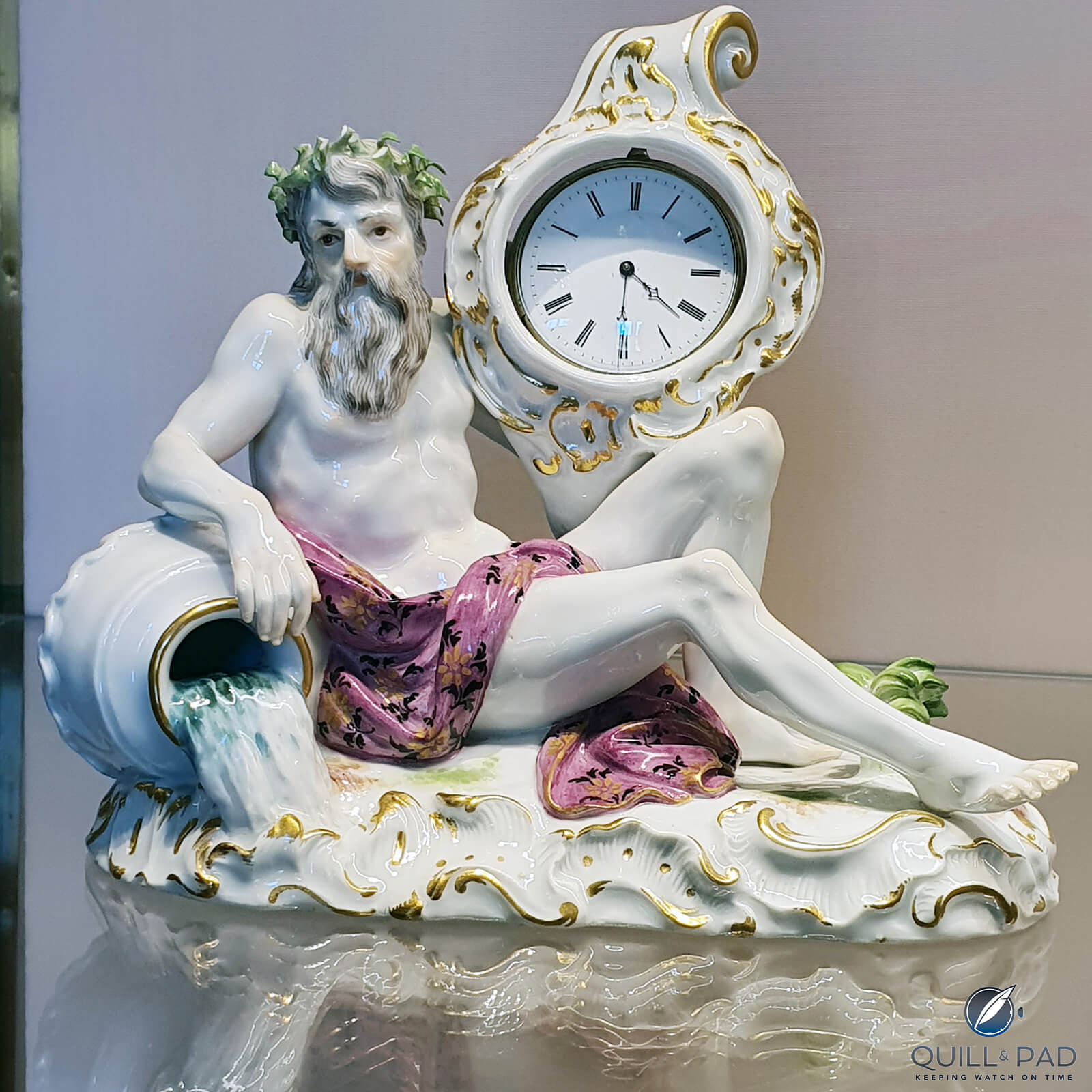
A Meissen watch stand with figure by Peter Reinicke, about 1747 (recast of the original model made about 1860) (photo courtesy Thomas Brechtel)
Porcelain clocks are available even today
The timepiece below showing the figure of a huntress and and her dog is a mantel clock from the current production of porcelain clocks of the Meissen workshop. It is a recast of an original piece designed by Paul Scheurich from the year 1937 and has an eight-day manual-wind movement. It is made in a limited edition.
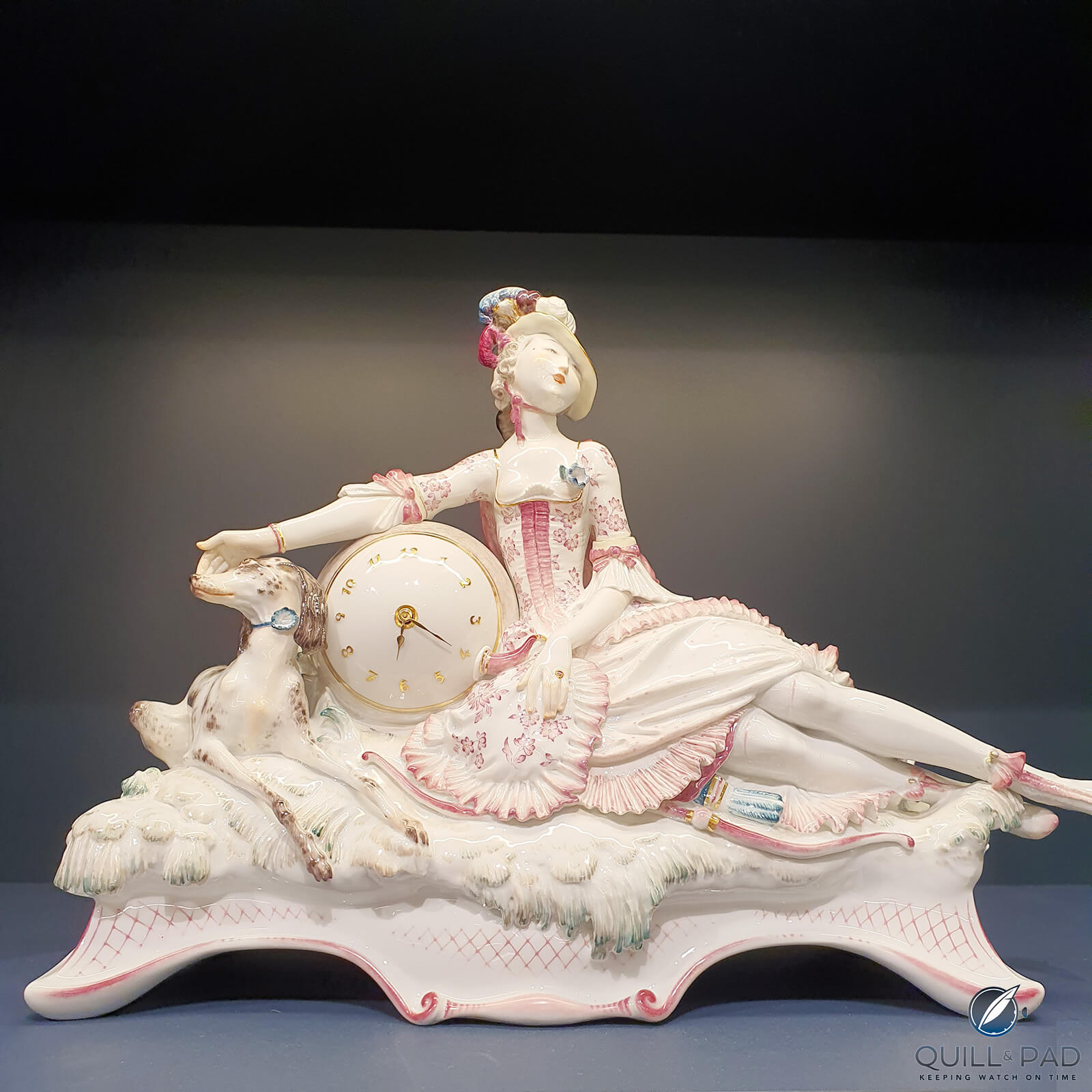
Meissen porcelain clock with huntress and dog with eight-day manual-wind movement, a limited edition recast of a clock originally by Paul Scheurich in 1937 (photo courtesy Thomas Brechtel)
What about the opening questions?
I confess that I appreciate the splendor, fine arts, opulence, beauty, and craftsmanship of clocks. Before visiting the collection in Meissen, though, I was not aware that clocks in cases made of porcelain even existed. I don’t usually get too excited when I see a well-known and spectacular clock or watch, but do when I see things I have never seen before.
Which is why I am grateful to the August the Strong’s collecting frenzy. And to the Meissen museum and manufactory for maintaining its collection. Whether these clocks have a large community of enthusiasts, I couldn’t say. It may be that some see it more like W. C. Fields and may think: the clocks of this collection are like a majestic elephant – we look at him very gladly, but would not like to have him at home.
For more information on Meissen porcelain, please visit www.erlebniswelt-meissen.com/en/experience/museum.
You may also enjoy:
Koma Kurabe: The Slim d’Hermès With Authentic Japanese Porcelain Enamel Dial
Focus On Technology: Pad Printing
Incredible One-Of-A-Kind OAK Collection Premieres At London Design Museum On May 19, 2022
Leave a Reply
Want to join the discussion?Feel free to contribute!



I am reminded of John Peel’s assessment of ELP. “An incredible amount of talent doing absolutely nothing”
All but two of these are monstrosities.
Thanks for the feedback Tam, and perhaps it is a comfort for you to learn: there is no compulsion to buy it, nor a compulsion to collect it. No fear, relax. Best, Thomas
But I truly like your comparison to ELP and … “the waste of electricity” : )
“A comfort for [me] to learn”?
Very bad choice of words.
Thank you for this insight into a world I didn’t even know existed, Thomas. Here in France it’s all ormolu and marble.
I am reminded of Chatwin’s novel Utz. I suspect that back in the day, Tam ‘o Banter above would have preferred to defect to the Soviet bloc to get away from his collection of Meissen clocks rather than to be reunited with it…
Thank you very much Colin. You describe exactly my own experience in your sentence: this was a world I didn’t know existed … in such quantity. Dresden and the surrounding area is somehow full of super collections. I (not being Baron Kaspar Utz with a ‘horrible museum’) was only a visitor to the collection, none is mine … but I also wanted neither to leave nor to be separated from some of the exhibits. ‘Life is grave, art is joyful’ , Thomas
What an absolutely pathetic comment
They are from a different time and mindset. I have been through that museum myself on several occasions and marvel every time at the artistry and skill. I have a deep appreciation for art pieces like this, though given the choice I usually choose Wedgwood jasper. However, I will admit to owning a Meissen piece or two. But they don’t look like these (though I admit I wish they did!).
The moment you enter this open and friendly place in Meissen, you feel like being on a different planet. It is a mix of museum, restauration workshop, school of art, university, … full of gentle people and creative characters. I hope that they and their art and skill is highly appreciated.
I have admired many non – Rococo pieces of Meissen myself. They are a wonderful company. However I emphatically stand by my previous statement.
Understandable. Definitely not everyone’s cup of tea.
Wonderful article, Thomas. Your pictures are great as well. I didn’t know porcelain shrank so much. That sounds to me like an extraordinary challenge in relation to the exacting tolerances needed for watch and clockmaking. Is the porcelain sculpted to the necessary dimensions after the firing process?
Hi Bruce and thank you for your nice feedback. Working with this material seems hard, … it is fragile, it is delicate, obviously you have to be prepared, that anything can happen until it is ready and finished as it should be. One has to have a high level of frustration-tolerance and a calm character and a high motivation. The visit was a huge surprise for me. I highly recommend making a stop-over in Meissen. Best, Thomas
It is my understanding that the shrinkage, which is usually between 13 and 16 percent, is taken into account when planning a piece.
you are absolutely right. All has to be planned and done BEFORE the fire comes
uups. and the answer is: all sculpturing has to be finished before firing, after the two firings, it is done. If it is not the way you liked it to be, if it cracks, if it is uneven of disproportionate … that’s it, you only can destroy it and do it anew. Sorry. Thomas